Following on from our interview with Michael Geldmacher and his appeal for the introduction of project development payments as standard in the furniture industry, we thought it appropriate, prudent, and correct, to ask other designers and design studios how they view the situation.
The views of one furniture designer representing an entire profession no more than one swallow maketh a summer.
To this end we conceived a short online questionnaire which we asked numerous European designers and design studios to complete.
From the very beginning we want to make it very clear that the following is in no way being presented as a definitive scientific analysis. It isn't. Not only can we not vouch for the scientific soundness of our questionnaire, but the number of respondents doesn't allow any unequivocal conclusions to be reached.
From the 100+ design studios we invited to participate, 25 did so. Statistically and scientifically completely irrelevant; however, a lot more than we were hoping for and certainly enough from which to elucidate one or the other very general conclusion.
The most glaring being that a more involved study is necessary.
In order to encourage studios to respond, and to do so quickly, we deliberately kept the responses anonymous and didn't ask too many detailed and/or commercially relevant questions. Consequently, although we invited a broad mix of recent graduates, establishing studios, established studios and "star" studios from across Europe to participate, we don't know who did, and so we cannot compare renown and experience with opinions, nor define any geographical differences. A few studios did contact us to say they had completed the questionnaire, but we don't know how they responded.
We also didn't ask about the percentages of the factory gate price the studios generally receive as royalties, how much that makes per year, and if they can survive from the royalty payments alone. All very relevant, central, questions, but given the fact the survey was hosted on a browser based freeware system, and so whose absolute security we couldn't guarantee, not something we wanted to ask. Plus we didn't want to scare off studios with whom we had no personal relationship by asking detailed commercial questions and thus not getting answers on the other issues.
It is also important to note that in no way should the following be understood as criticism of manufacturers. Of setting up an "us" against "them" scenario. It's simply about reflecting designers views and opinions on the conditions they experience in their profession. The manufacturers will get their chance to respond. Of that we promise you.
That all being understood and accepted........
In terms of the responses received the major surprise for us was that the majority of the respondents had more than 6 furniture/lighting projects in production:

Owing to the anonymity of the questionnaire and the associated problem of trying to differentiate the responses of the bigger, more established studios from those of smaller, younger ventures, we thought a clever way of doing such would be via the number of products in production.
"Older + bigger = more products", being our (in)fallible logic.
The fact that some 50% of respondents have more than 6 products in production means either that the respondents are pathological self-deceivers who desperately want to appear more successful than they actually are, even in anonymity. Or that we misjudged where to set the cut off point for measuring big vs. small and that 6+ products isn't that rare.
One must naturally also add that having products in production doesn't necessarily equal financial security, the products also have to sell, which is of course one of the central criticisms of the current system: too many products simply don't sell enough and/or for long enough to generate a real financial reward for the designers. And lest we forget - designers live from designing.
In which context, among the more interesting responses from our survey was that 87% of respondents had experienced that a project developed for a manufacturer subsequently hadn't been taken on.
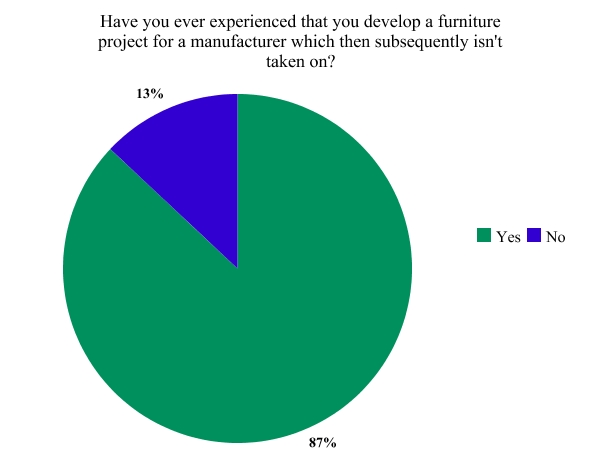
Such clearly can happen, the reasons why it happens being as plentiful as PR professionals at Milan Design Week. But it is the confirmed obviousness which makes it important. In conversation with, generally, young designers the subject regularly turns to the fact that they are in discussions with this or that manufacturer about this or that project. A year later when we ask how things are going, it's invariably moving slowly but they are still working on it. And a year later its all over. Which is two years of wasted time and investment for both parties. When that waste is equally shared it is regrettable but fair. When one side suffers more "damage" than the other, it isn't. From our survey we have no information as to if projects that are subject to a development fee are more likely to be ultimately taken on or not, something which is obviously critical to correctly analysing the data and which should form part of any future survey. However alone the confirmation that almost all designers experience such on a, more or less, regular basis appears to underscore arguments for a change in how designers are paid; not least because it would ensure a fairer spread of the financial consequences of a project being abandoned.
Unsurprisingly a majority of respondents find the current royalty system unfair. Which we all kind of knew. Much more interesting is the views on alternatives where our respondents are unambiguous: Development payments as standard.
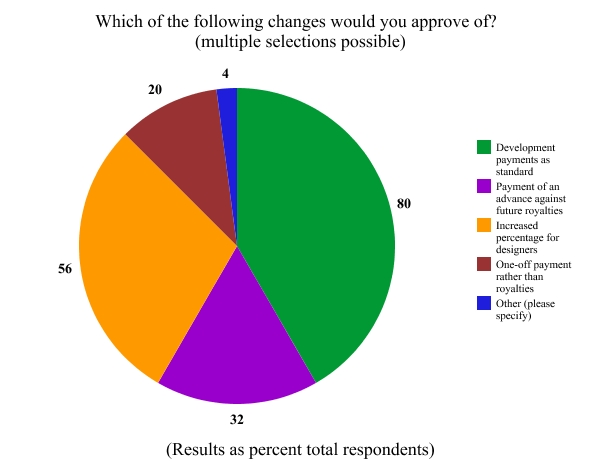
Despite this clear agreement on the value and importance of development payments, only 25 % of our respondents normally ask for such, a further 16% indicated that it depends on project and producer. A third of respondents meanwhile do not normally ask for development payments.
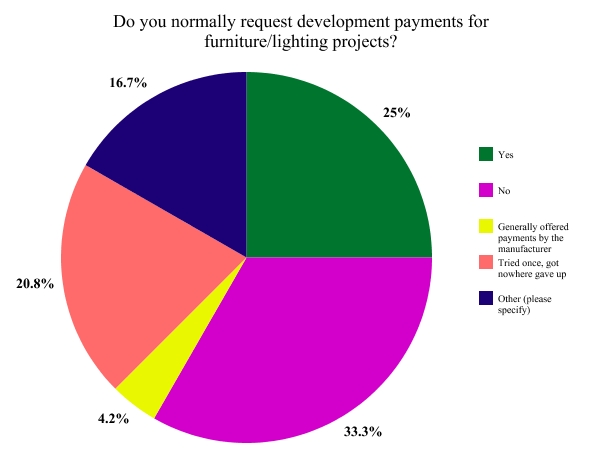
Interestingly however, from the 33% who don't normally ask, a third said they had received a development payment: a fact which would tend to indicate that there are producers who offer such as standard, and that asking may not be as fruitless an exercise as many designers appear to think it is.
Especially when one considers that 62% of respondents have received a development payment. Clearly such a statistic doesn't mean that 62% of studios always receive a devlopment payment, but does tend to imply such are more common than one could be led to believe, and that by extrapolation, ignorance of the conditions under which colleagues are working could be the designer's biggest problem, and that a more open culture could therefore be beneficial.
Something particularly worth pointing out to those 20% of respondents who tried once, got nowhere and gave up. And of course to any young designers who are approached in Milan by a manufacturer with intentions of producing their project.
The most notable response in the above chart is without question the one studio who state that they are "Generally offered payments by the manufacturer", and who thus, and assuming they're not being painfully ironic, have achieved the Nirvana sought by all other respondents. We have no idea who it is, the logical assumption, also based on their other responses, is that it would be one of the bigger studios, it may of course be a smaller studio who got lucky, either way should they want to discuss how one reaches such a position, we'll be in Milan..................
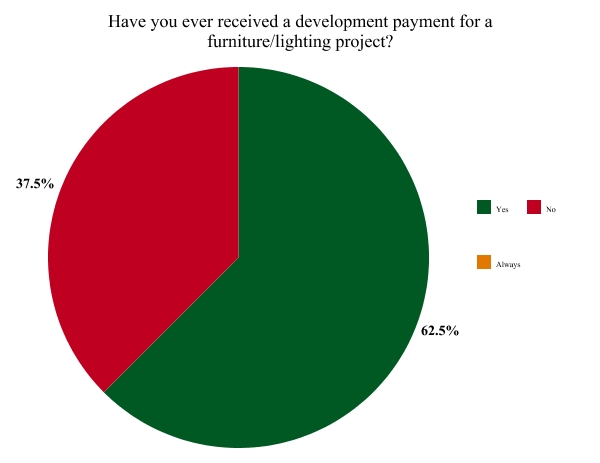
Away from questions of payment we also asked about the press, relationships with the press and views on the way the press cover design. We'll save those results for a later post; however, a regular response concerned the lack of genuine reflection and criticism by the press, that the press aren't perceived as taking their responsibility in terms of design seriously enough, one respondent noting, not without justification, that by writing uncritically about a product simply because it is "new" without questioning if it is also "good" one harms design.
Which is just something we'd like to pass onto all those bloggers out there busily packing their rucksacks and rose-tinted spectacles for Milan. Before you post about a "beautiful" and "fantastic" new chair, lamp or shelving system...... question if the world needs it. The general answer is no. There are naturally many, many exceptions. The general answer however is no. One should never forget that.
Yes, we know, we're setting ourselves up for a huge, painful and very public fall......... Again.
More generally in terms of Milan, the most shocking aspect of the survey for us was the fact that from those who completed our questionnaire 84% responded to the question "Is Milan worth it?" with the answer yes!!
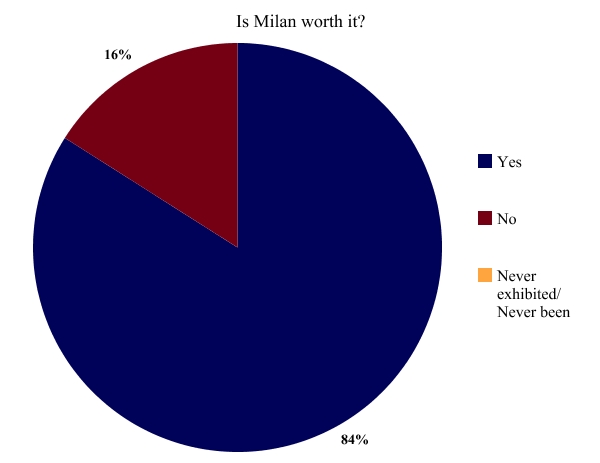
Shocking as the reaction is and was, it wasn't completely unexpected. A few years ago we spent most of our time in Milan asking designers if they thought it was all worth it, the general response then as now was yes, the general reasoning perhaps being best summed up by Konstantin Grcic and his statement that Milan "defines the rhythm of the whole industry. We as designers start now in May with preparations for next year, and when Fuorisaloni wasn’t there a lot of things would inevitably fall by the wayside."
But that was asking designers directly, we kind of figured that in the comfort of an anonymous survey they would concede that it is all a huge waste of everyones time and money as well as those few resources our earth can still spare and that in our modern world there must be better, more creative, alternatives.
However, much as Gustave Le Bon was wrong that anonymity causes rational individuals to lose their "sentiment of responsibility", and to "yield to instincts which, had he been alone, he would perforce have kept under restraint", so to were we wrong that anonymity would cause rational designers to lose their sense of allegiance to the bloated anachronism that is Milan Design Week.
Yes, we'll be in Milan. If as ever more by coercion than desire.
As we noted at the beginning, the above results cannot in anyway be considered a definitive scientific analysis of the design profession. Can however be considered as a quick snapshot of the mood of a section of the design profession.
What the results do however provide is a few insights which we believe would remain true in a larger scale, scientific, study. Which is what we'd really like to see, an institution who has the resources, and for all the international reputation, to undertake a more detailed survey which also tackles financial aspects in real depth. Ever more designers competing in an ever more fragmented, short-term focussed market where questions of "lifestyle" increasingly dominate over those of "design" invariably requires a contemporary payment system which properly rewards the designers while leaving manufacturers the commercial freedom to operate and manage their portfolios as they wish. In order to achieve such one must however fully understand the "is" situation. In addition, with only very few design schools teaching their students about the business aspects of the industry, the professional institutions need to take the lead and inform would-be designers of the reality that awaits them. Not least because that may persuade one or the other youngster not to follow a furniture design career, which may, finally, halt the unsustainable growth in design Masters courses....................
The full results of the 2015 smow blog designer survey results can be found here
And many thanks to all who participated.